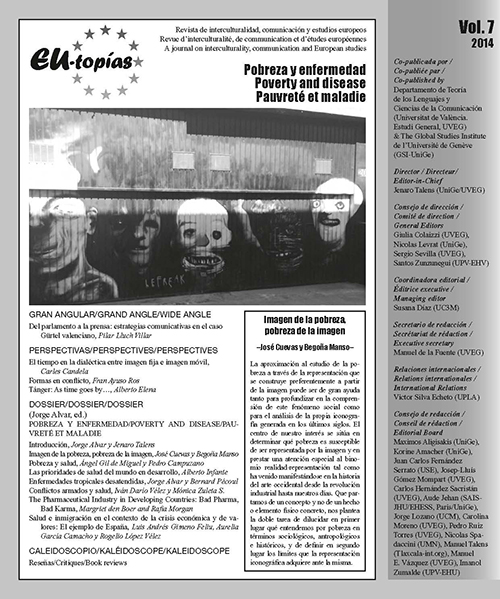Imagen de la pobreza, pobreza de la imagen
DOI:
https://doi.org/10.7203/eutopias.0.18836Keywords:
Disease, poverty, social imbalance, image and representation, cinema, photography Abstract
Abstract
Poverty is the result of a social imbalance, and is characterized by having a large percentage of the population forced to a miserable and subhuman situation in terms of health, education, nutrition, housing and emotional development. Its origins can be traced to the production and power relationships in different stages of history. The image of poverty created and seen in visual arts, photography and cinema through the centuries constitutes an ideological intervention, at the service of certain social classes and groups. The dialectic confrontation taking place between such groups can also be seen in the depiction of poverty, ranging from idealization, concealment and distortion to a critical and politically engaged point of view which tries to bring that reality to light. An analysis of poverty through the use of its constructed image throughout time –from the industrial revolution up to this day as it is done in this article– establishes a very interesting crossroad for sociology, anthropology, history and theory of the image.
 Downloads
Downloads
 References
References
ADORNO, Theodor, W. (1972) Lucaks y el equívoco del realismo. En Polémica sobre el realismo (VV.AA). Buenos Aires. Editorial Tiempo Contemporáneo.
ARISTÓFANES (2000). Pluto. Madrid, Ediciones Clásicas.
BABCOCK, Barbara (1978). Introduction. En The Reversible World. Symbolic Inversion in Art and Society. Londres. Cornell University Press.
BARTHES, Roland. (2009). Mitologías. Madrid, Siglo XXI.
BARTHES, Roland. (1969). Principios y objetivos del análisis estructural. Madrid. Alberto Corazón Ed.
BENJAMIN, Walter. (2007). Experiencia y pobreza. En Obras. Libro II, vol. 1. Madrid, Abada Editores.
BULLOCK, H, E; FRASER, K, F; y WILLIAMS, W, R. (2001). Media Images of the Poor. Journal of Social Issues, Vol. 57, No. 2, pp. 229-246.
CASTELLS, Manuel. (1997). La era de la información. Economía, sociedad y cultura. Vol. 3 Fin de milenio. Madrid, Alianza Editorial.
DEBORD, Guy. (2003). Comentarios sobre la sociedad del espectáculo. Madrid, Anagrama.
DIDI-HUBERMAN, Georges. (2008). La emoción no dice “yo”. Diez fragmentos sobre libertad estética. En: Schwiezer, Nicole (Coord), La política de las imágenes: Santiago de Chile, Metales pesados. pp. 39-67.
FAROCKI, Harun. (2013). “Cómo abrir los ojos”, prólogo al libro “Desconfiar de las imágenes”. Buenos Aires, Ed: Caja Negra.
GEMEREK, Bronislaw. (1989). La piedad y la horca. Madrid. Alianza Editorial.
HARVEY, David L, y REED, Michael. (1992). Paradigms of Poverty: A Critical Assessment of Contemporary Perspectives. International Journal of Politics, Culture and Society, Vol. 6, Nº 2. pp: 269-297.
HAUSER, Arnold. (1985). The Social History of Art. New York. Vols. 1-4. Nueva York, Vintage Books.
HEIDEGGER, Martin. (2010). El origen de la obra de arte. En Caminos del bosque. Madrid, Alianza Editorial.
HIMMELFARB, Gertrude (1984). The Idea of Poverty. England in the Early Industrial Age. Londres, Faber & Faber.
LANZMANN, Claude. (1985). Shoah. (Documental). LiFCFilms.
LEPIANKA, D; OORSCHOT, W, V; y GELISSEN, J. (2009). Popular explanations of Poverty: A Critical Discussion Of Empirical Research. Journal of Social Policy, 38, 3, 421-438. Cambridge, Cambridge University Press.
LEWIS, Oscar (1965). Antropología de la pobreza. [Título original: Five Families (Mexican Case Studies in the Culture of Poverty; Basic Books, Inc. 1959]. México, Fondo de Cultura Económica.
LIZ, Catharina y SOLY, Hugo. (1979). Poverty and Capitalism in Pre-Industrial Europe.Bristol, The Harvester Press.
MARTÍN MUNICIO, Ángel. (2001) Desarrollo científico y médico. Higiene y salud pública. En: Iglesias, Carmen (Coord); Ilustración y proyecto liberal. La lucha contra la pobreza.Zaragoza, Fundación Ideas e Investigaciones Históricas. pp. 187- 223.
MAZA ZORRILLA, Elena. (1987), Pobreza y asistencia social en España. Siglos XVI al XX. Valladolid. Secretariado de Publicaciones Universidad de Valladolid.
MOLLAT, Michel. (1988). Pobres, humildes y miserables en la Edad Media. México. Fondo de Cultura Económica.
MORAIS, Alberto. (2008). Un lugar en el cine. (Documental). Un lugar en el cine, SL.
NOCHLIN, Linda. (1991). El realismo. Madrid, Alianza Ed.
RANCIÈRE, Jacques. (2008). El teatro de las imágenes. En: Schwiezer, Nicole (coord.), La política de las imágenes: Santiago de Chile, Metales pesados. pp 69-89.
ROMERO TOBAR, Leonardo. (2001). Reflejos de la pobreza en la literatura y en la prensa del siglo XIX. En: Iglesias, Carmen (coord.); Ilustración y proyecto liberal. La lucha contra la pobreza. Zaragoza, Fundación Ideas e Investigaciones Históricas. pp. 249- 271.
SHEROVER, Erica. (1979). The Virtue of Poverty: Marx´s Transformation of Hegel´s Concept of the Poor. Canadian Journal of Political and Social Theory, Vol. 3, No. 1. pp. 53-66.
SIMMEL, Georg, y JACOBSON, Claire. (1965). The Poor. Social Problems, Vol. 13. No 2. Pp. 118-140.
TORTOSA, José M. (1993). La pobreza capitalista. Madrid, Tecnos.
United Nations (1995). The Copenhagen Declaration and Programme of Action. New York: United Nations.
VEBLEN, Thorstein. Teoría de la clase ociosa. Madrid, Alianza, 2003.
VAN GOGH, Vincent. (1991) Cartas a Theo. Barcelona, Editorial Labor.
WARHOL, Andy. (1985). America. New York. Haper and Row Publishers.
Downloads
Published
How to Cite
-
Abstract1295
-
PDF (Español)637
Issue
Section
License
![]()
The authors conserve the copyright. All content published in EU-topías. Journal of interculturality, Communication, and European Studies are subject to the license Creative Commons Attribution-NonCommercial-ShareAlike 4.0 license. The full text of the license can be found at <http://creativecommons.org/licenses/by-nc-sa/4.0>
They may be copied, used, disseminated, transmitted and publicly displayed, provided that:
- The authorship and original source of the publication is cited (journal, publisher and URL of the work).
- They are not used for commercial purposes.
- The existence and specifications of this license of use are mentioned.
It is the responsibility of the authors to obtain the necessary permissions for images that are subject to copyright.



